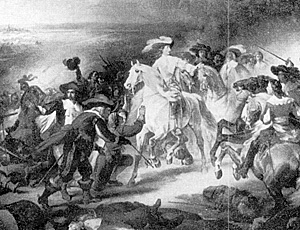
Duc d'Enghien calls a halt to the slaughter of the defeated Spaniards after the battle of Rocroi, 1643
Armies of the period were little more than armed mobs. With the exception of Spanish (particularly in the Lowlands) and early Swedish armies, the modern military requirements of discipline, training and logistics were largely rudimentary concepts. Most non-national armies were composed of groups of armed men recruited from the same region, volunteers for religious or economic reasons, or more commonly, hired units of mercenary soldiers. These mercenary forces in the main included veterans or other troops dismissed or let go by various generals or war lords who rose and fell in the continuous ebb and flow of fighting throughout the war. In the last 15 years of the struggle the majority of armies in the field were essentially mercenary in nature, multi-national in content and increasingly driven by plunder and opportunity.
It is true to say that not all armies were mercenary in the strictly modern sense. At the beginning of the war England sent a small well-motivated army of volunteers. With nobles, gentlemen and commoners alike serving as musketeers and pikemen, the expeditionary force marched deep into Germany to support the cause of Elector Frederick of the Palatine and his adored princess Elizabeth, daughter of James I. When many subsequently joined the armies of the United Provinces, Denmark, Sweden and even the Holy Roman Empire, they were following a long established practice of continental veteran professional soldiers that dated from the Italian Wars of the past century. The Anglo-Irish officers Wallenstein appointed to his "general staff " were motivated more by the likelihood of guaranteed wealth than fighting for a just cause. Ultimately the paymaster called the tune, a theme emphatically demonstrated by the flood of French money that bolstered the Protestant (anti-imperialist) cause in the last half of the war. The careers of von Mansfeld and Bernard of Saxe-Weimer were totally reliant on distant and often unreliable paymasters. The Scottish regiments of Denmark and Sweden were financed by English, Dutch and French subsidies. Without wealthy donors the Protestant cause was lost and without Spanish and Papal gold the Emperor in Vienna could never win. That one would eventually triumph and the other fail was arguably more a vindication of economic power than military prowess.
The effect of these barely disciplined armies on the German states was devastating. A typical early 17th Century European army roughly comprised 1/4 fighting men and 3/4 non-combatants. Trailing the soldiers was a virtual moving community of camp followers, priests, traders, stockmen, servants, ostlers, wheelwrights, prostitutes, captives, murderers, gipsies, vagabonds and thieves. It was no wonder that they were likened to plagues of locusts, stripping the land of all value as the armies passed through. Even friendly open or so-called free towns were in danger. If a town was lucky, and the visiting army was well paid, well behaved and well motivated, it survived and sometimes even prospered. More often than not the reverse prevailed, the countryside ruined and the town sacked and devastated. The tragedy was this happened not once but countless times with the appalling result that the population and economy of central German states fell to their lowest levels since the great plagues of the Middle Ages.
More Thirty Years War: Holistic Approach
-
Part 1: "For as Long as Spinola Wills It"
Part 2: "The Lion of the North"
Part 2: Leaders
Part 2: Armies
Back to Table of Contents -- Kriegspieler #6
To Kriegspieler List of Issues
To MagWeb Master Magazine List
© Copyright 1999 by Kriegspieler Publications.
This article appears in MagWeb (Magazine Web) on the Internet World Wide Web.
Other military history articles and gaming articles are available at http://www.magweb.com